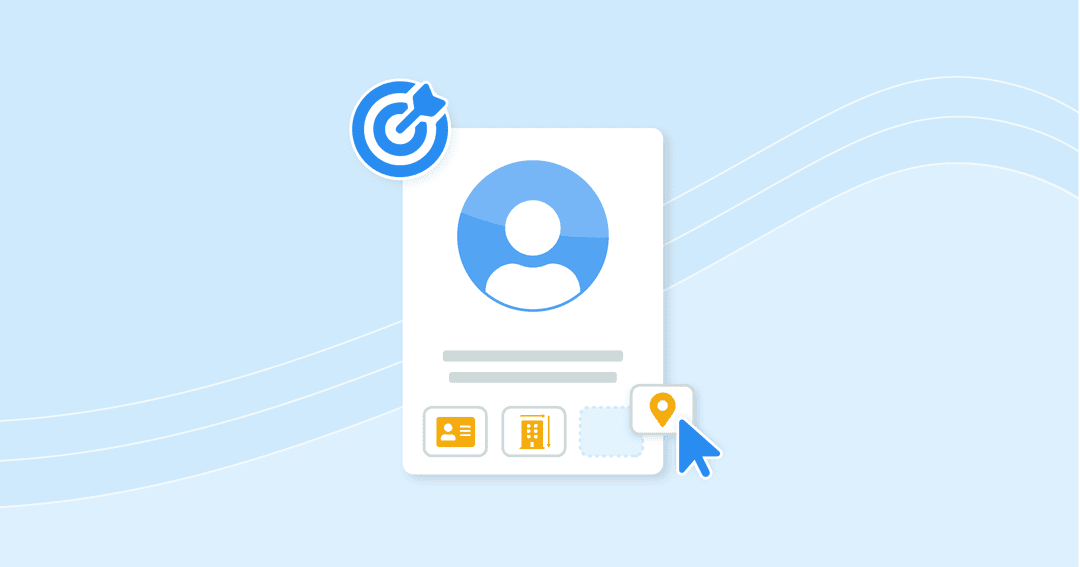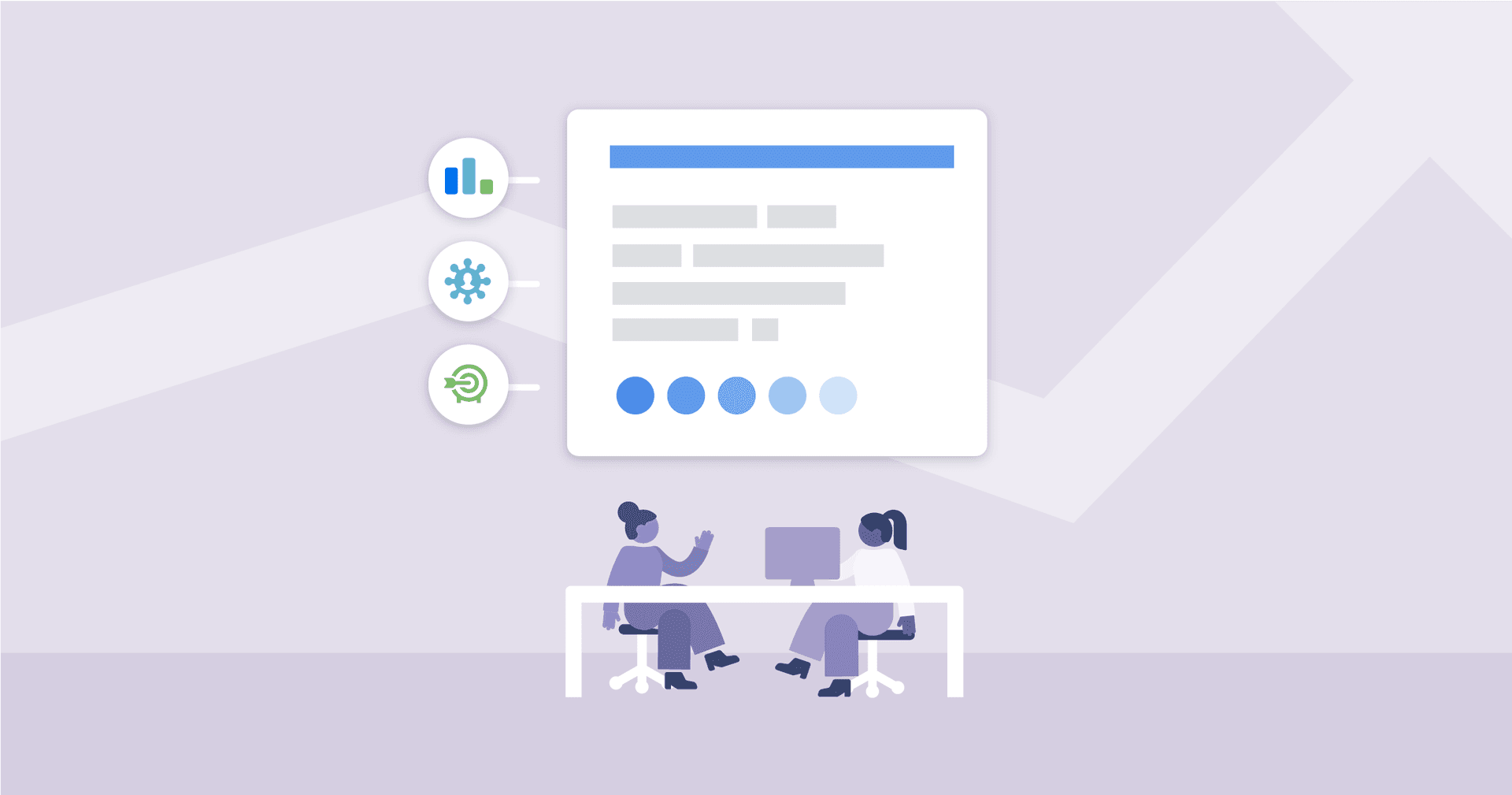Table of Contents
Table of Contents
- What Is an Ideal Client Profile?
- What’s the Difference Between Ideal Customer Profile Vs. Buyer Persona?
- ICP + Buyer Persona = Growth Powerhouse
- You Absolutely Must Have a Client Profile; Here's Why
- How to Create an Ideal Client Profile
- Where to Find All This Information?
- The Limitations of Creating an Ideal Customer Profile
- Example of an Ideal Customer Profile
- Strategies for Applying Your ICP
- Tailoring Outreach Based on Buyer Personas
- Putting It All Together: The Client Profile Template
7,000+ agencies have ditched manual reports. You can too.
Free 14-Day TrialQUICK SUMMARY:
Defining an ideal client profile involves creating a detailed representation of a company’s perfect customer, based on market research and existing customer data. This article provides a comprehensive guide on developing this profile, highlighting demographic, firmographic, and psychographic characteristics, as well as buying patterns, pain points, and goals. Plus, a free downloadable guide and client profile template for constructing impactful client profiles.
Do you struggle with attracting ideal clients?
Have you ever wondered why other agencies seem to win your dream accounts? Let’s be honest, growing a marketing agency is more challenging than it looks, especially when it comes to navigating the complexities of digital marketing to reach and engage your ideal clients.
There’s likely not a day that goes by that you don’t try and figure out how to get the right customers to notice your company and what to say to win them over.
In this post, I’ll show you how to do both.
You’ll learn how to define and create your ideal client profile. You will then use this information to improve your sales and marketing and finally attract and win your best accounts over.
Let’s get started.
What Is an Ideal Client Profile?
An ideal client profile is a detailed description of a company’s hypothetical perfect customer, based on market research and real data about existing customers. It includes demographic, firmographic, and psychographic characteristics, as well as buying patterns, pain points, and goals of the target customer.
This client profile guides businesses in tailoring their marketing and sales strategies to attract and retain the most valuable and compatible clients, ensuring a more focused and effective approach to business growth.
What’s the Difference Between Ideal Customer Profile Vs. Buyer Persona?
Though closely related, these concepts address different, yet complementary, aspects of understanding your ideal client:
ICP: The Blueprint Your ICP focuses on the company itself. It outlines the type of organization you thrive working with, using concrete traits like industry, size, revenue, and tech stack. Equipping your agency with these insights guides your business development pursuits and narrow outreach efforts to highly targeted, relevant leads. This ensures the best use of your agency’s time and increases the likelihood of onboarding clients you actually want to work with.
Buyer Persona: The Human Element Your buyer persona gets personal. It's a deep dive into the individual decision-maker within your ideal client company. This includes their motivations, pain points, communication preferences, and the factors influencing their choices. For example, a VP of Marketing and an SEO Manager may both have hiring power but entirely different experiences. By understanding the characteristics of each persona, you will be able to create tailor-made SEO proposals, relatable content, and conversational insights when cold calls are made.
Agencies that clearly distinguish between these two frameworks see more focused lead generation, shorter sales cycles, and stronger client retention.
Feature | ICP (Ideal Client Profile) | Buyer Persona |
|---|---|---|
Focus | Company-level | Individual-level |
Traits | Industry, size, revenue, tech stack, etc. | Job title, pain points, decision-making style, etc. |
Purpose | Targeting outreach efforts | Personalizing communication |
ICP + Buyer Persona = Growth Powerhouse
When used together, your ICP and buyer personas give you a laser-focused strategy. Your ICP identifies the most promising fields to play in, and buyer personas arm you with the map to successfully navigate them. This leads to higher close rates, stronger client relationships, and a thriving agency.
Equipping your agency with these insights guides your business development pursuits and narrow outreach efforts to highly targeted, relevant leads. This ensures the best use of your agency’s time and increases the likelihood of onboarding clients you actually want to work with.
As AI-driven prospecting and personalization tools become more common, a well-defined ICP ensures these automations stay human and relevant. Instead of chasing every lead, agencies feed high-quality ICP data into tools like HubSpot, or LinkedIn Sales Navigator to prioritize outreach that actually converts.
You Absolutely Must Have a Client Profile; Here's Why
Let’s not beat around the bush here—most agencies struggle to get clients regularly. Client acquisition might be one of the biggest pain points for marketing agencies—but it’s also one of the biggest opportunities. The agencies that grow fastest aren’t the ones chasing more leads; they’re the ones that know exactly who they want to work with and why
For example, 60% of Hubspot’s Agency’s Growth report respondents named it as their agency’s most significant pain point:

Similarly, The State of Inbound report by Hubspot confirmed that lead generation remains the top marketing challenge for businesses:

And even our own Marketing Agency Benchmarks survey listed client acquisition as one of the top challenges faced by today's marketing agencies.

Not to mention that many agencies regularly complain about their struggles with positioning in the market. And if you ask me, the primary factor behind this is a lack of understanding of who your ideal clients are.
Now, I admit that most agencies would have some idea about their target audience. It could be an industry they typically work with or company size, but such targeting is simply too broad and makes it difficult to grow.
For one, as research shows, only 1 out of 10 people in your target market would actually require your help. Although meeting the general target characteristics, the remaining nine are unlikely to need an agency’s help.
Targeting a broad audience can often use a significant portion of your marketing efforts and budget, but the question is: can it deliver any meaningful return? And, of course, can having a better understanding of your agency's ideal client reduce the customer acquisition cost?
It’s doubtful—after all, if 90% of your marketing message is being ignored, you’ll be spending money and time reaching potential clients that will never convert.
And so, defining that one lead most likely to become a client will help you:
Plan and launch more successful marketing campaigns.
Optimize your marketing communications, including your language and how you communicate relevance to your prospect’s needs.
Reduce the marketing spend and the customer acquisition cost (CAC). Specifically, you’ll achieve this in two ways: one, by not wasting resources on audiences that will never convert; and two, by attracting ideal clients with whom you can build long business relationships.
Improve your sales process and sales strategy. For your sales team, understanding your ideal client’s pain points means knowing precisely what to say to a prospect to win them over.
Create more relevant content. Every blog post or guide is targeted only to attract the most qualified visitors.
Boost lead generation and save time on low-quality leads and tire-kickers.
So how do you define them? You guessed it; by creating a profile for your ideal client.
You’ve probably heard of buyer personas or customer profiles. Creating a client profile isn’t that different. It simply focuses on specific characteristics important to the client & agency relationship.
Not only will this help fine-tune your client acquisition strategies, but doing so will also help with some of the other common marketing agency pain points, such as client reporting, client retention, and meeting deadlines. After all, once you know exactly what kind of client your agency is targeting, you’ll have a more transparent lens to focus on acquisition and client management processes.
So, let’s get started on creating your client profile.
How to Create an Ideal Client Profile
1. Professional Profile
A typical business misconception says that when selling, you target companies.
The reality is, however, that every business is made up of people. They work in different positions, have various responsibilities, and so on. The key to your sales success is simply connecting and engaging with these individuals—not the entire company.
That's why it’s best to start with understanding who your target personas are. To uncover this information, define the following:
The person's role
Skills they require to do their job
Typical responsibilities and how is their work measured
Who do they report to?
Who else might be involved in the decision to hire you?
For example, let's say I'm targeting VPs of Marketing at construction companies. Their professional profile would look like this:
Role: VP of Marketing
Skills: Planning, persuasion, writing, and diplomacy to help navigate through office politics.
Typical responsibilities: Developing and implementing a marketing plan, managing long-term goals for various teams, and so on.
Reports to: CEO and CFO
This information would then help design both the sales message and the sales process to engage these prospects better.
2. Problems, Challenges, and Pain Points
Remember, your goal is to learn enough about a person to engage with them more effectively. The next step is to understand the problems, challenges, and pain points that would drive your client to hire an agency.
Let's use the VP of Marketing in a large building company as an example again. The person would likely face several challenges, including:
Generating more inquiries that convert into sales-ready leads
Prioritizing marketing strategies
Measuring marketing effectiveness
Demonstrating the value of their work to the C-Suite
However, a managing partner in a small, ambitious law firm would have different needs. They might want to increase the number of open cases without being actively involved in the process or position the law firm as cutting edge in the industry.
You also don't need to limit these customer drivers to marketing goals. Keep in mind that clients look for an agency for many other reasons.
Is your target client an entrepreneur running a business on their own? Their primary driver may be that they're simply too busy to manage all marketing tasks. When you understand this and pitch your services as a way to reduce their workload, it will resonate with the prospect much more.
Understanding their drivers will be crucial to how you pitch yourself to prospects. When you know why specifically they are looking to hire you, you'll be able to align your services with their goals in the sales process.
3. Personal Characteristics
There is an undeniable correlation between how well you connect with clients and your agency's success.
Michael Port explains it this way in his amazing book, "Book Yourself Solid"
"When you work with the clients you love, you'll truly enjoy the work you're doing; you'll love every minute of it."
And for that reason alone, your client profile must include characteristics you value in people.
A few questions that will help you gather the right information include:
What do you value in people in general?
What are the personal characteristics of your best clients?
What do you have in common with your best clients?
What makes you excited about the prospect of working with them again?
4. Company Information
Finally, consider where your ideal clients work. Particularly, look for similarities that define a niche or specific business type to whom you deliver your best work.
For example, consider the following:
Is there one industry you deliver your best work in?
Common company sizes?
Location?
Revenue level?
What is their typical sales process? This information will help you design a campaign aligned with their buying process.
How do they look for vendors, and what process do you need to start working with them?
When defining the company information, this is the time to consider whether you will be a niche or general marketing agency.
There are countless examples of SEO agencies that focus on a specific niche with enormous success.
When you work within a niche, it's easier to pitch yourself as a marketing expert in that industry.
You'll also know where to focus your attention. What Facebook groups or trade shows does your target client participate in? What type of events cater to this industry?
Of course, there are downsides to a niche agency too. That being said, use your client profile template as an opportunity to explore and define your industry.
💡 ICP Metrics to Track
Once your ICP is defined, track how closely new leads align with it. Useful metrics include:
Percentage of new leads matching ICP criteria
Conversion rate of ICP-qualified leads
Average client lifetime value (CLV) by ICP segment
These numbers help your agency validate whether your ICP truly reflects your best-fit clients.
Where to Find All This Information?
You have multiple data sources at your disposal. Some deliver accurate insights unquestionably, and others may require some assumptions about your target clients.
Nonetheless, let's discuss them.
The most valuable data source for your client profile is, of course, your best clients—including any current or past client.
If you want to attract similar people, it makes sense to mirror the client profile of the best clients you've ever had.
You have several ways to gather the information you need about them:
Interviews: Call existing clients and ask them about their pain points and characteristics directly. You can do the same with past clients.
Email conversations: If you can't talk to them in person, review your emails, meeting notes, etc., to find answers to the questions above.
CRM data: You should be able to see a lot of insights about them in notes, deal comments, geographic location data, and emails saved there too.
However, you might just be starting. As a result, you don't have any company data or client history to draw insights from. Or you want to shift your focus and attract completely different ideal customers from now on. In that case, use a Google search to learn more about those people.
Although you may not find the most accurate insights, the following sources might help you learn more about your target audience:
Industry research or reports. Ideally, focus on documents published by industry associations and other professional bodies. Or conduct market research of your own.
Customer discussions on online forums, industry communities, Q&A sites, etc.
Job sites. Reviewing relevant job descriptions will help you discover your ideal client's responsibilities, skill sets, and challenges.
The Limitations of Creating an Ideal Customer Profile
I’m all for creating an ideal customer profile because it can really help you to make informed, strategic decisions. There are a few limitations to keep in mind, but don’t let this deter you from getting the most out of this critical exercise.
Be sure that you don’t:
End up with an ideal customer profile that’s too broad by casting too far of a net. If you make too many generalizations and insufficient specific inferences, you’ll end up with an ideal customer profile that doesn’t capture the essential details you need.
On the other end of the spectrum, getting too hyper-focused and excluding important details will end up in a customer profile that’s not ideal. Those insights are invaluable, but use your discretion to know how much detail is too much.
Because an ideal customer profile is heavily based on real-life company characteristics, some clients may have privacy concerns about using their data in any extrapolation exercise. Wherever possible, try not to use characteristics identifiable to a specific company. You want something as a general representation, so avoid adding enough particular details that someone could go, “that’s THIS company.”
While creating an ideal customer profile has tremendous benefits, it may also come with a significant financial investment if it’s being outsourced. Don’t rule it out, though. A dedicated internal resource with in-depth knowledge of customers can do the trick here. Alternatively, explore supplier options that can work within your agency’s budget.
Remember that creating an Ideal Client Profile doesn’t mean your agency is turning away business. If your agency were to market a particular client’s product to a 35-year-old female living in New York, you know there is still a chance that a 42-year-old female living in New Jersey might still purchase the item. The point of an ICP is to provide focus, not necessarily exclusion.
However, there are certain areas where exclusions may apply. For example, your agency could decline the opportunity to work with a client that is too far outside your geographic comfort zone, but that is something your team can decide on a case-by-case basis.
In summary, evaluate where your agency is and how much investment is realistically feasible (both time and financial). Also, strike that balance between outlining customer profile characteristics without being too vague or tunnel-visioned so that the overall picture is closer to reality.
The key is balance—your ICP should evolve as your agency does. Revisit it quarterly, especially as your client base grows or new service offerings emerge.
Example of an Ideal Customer Profile
Let’s continue with our construction company example above. Say your agency is trying to onboard more clients within this industry. Using a handy client profile template helps you understand who you’re trying to target. Having had a longstanding client relationship means you know the ins and outs of their experience. You’re also able to make inferences about this type of client. An ideal customer profile would look something like this:
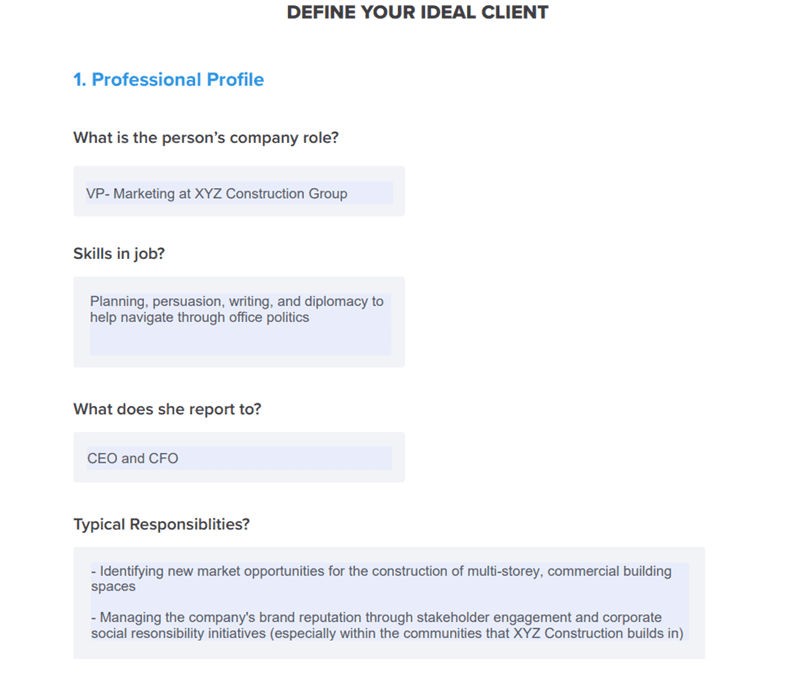
As you can see, we’ve outlined the key decision maker at XYZ Construction Group to who your agency can reach out for a pitch opportunity.
Next up, consider what a VP of Marketing may be experiencing in their role and why the services of an agency would be needed in the first place.

Outlining these challenges helps your agency have a tailor-made, strategic approach while showing that you’ve done your research. Based on the above, your agency emphasizes its years of experience in reputation management and even current case studies that show successful outcomes.
Also, consider the characteristics of your ideal client within this sphere. While your agency actively pursues new business opportunities, it can be tempting to onboard any client that comes your way.
Category | Details |
|---|---|
Decision Maker | VP of Marketing |
Customer Drivers | Generating more sales-ready leads, prioritizing marketing strategies, demonstrating ROI |
Personal Characteristics | Values collaboration, data-driven, open to innovation |
Firmographics | Construction industry, mid-sized to large, US-based |
However, you’ll want to ensure alignment between your agency and new prospects to avoid any difficulties in the future. That’s where outlining value synchronicities come in handy.
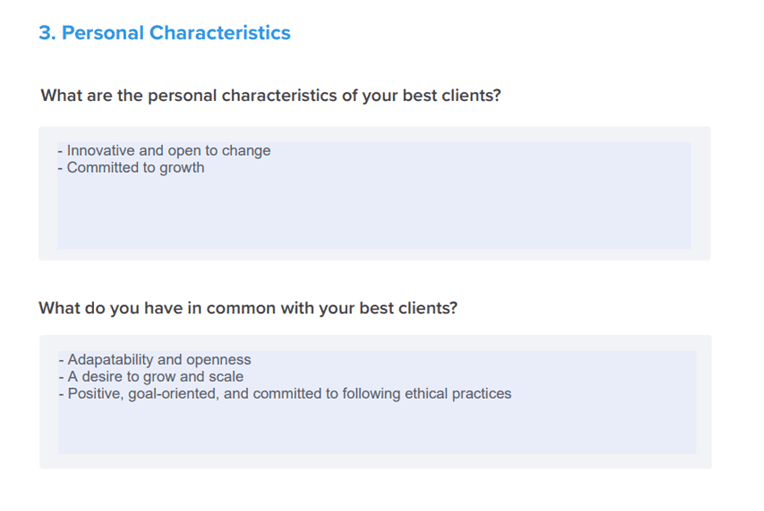
Finally, consider the firmographics of your ideal customer. This further streamlines the type of client you should actively pursue.
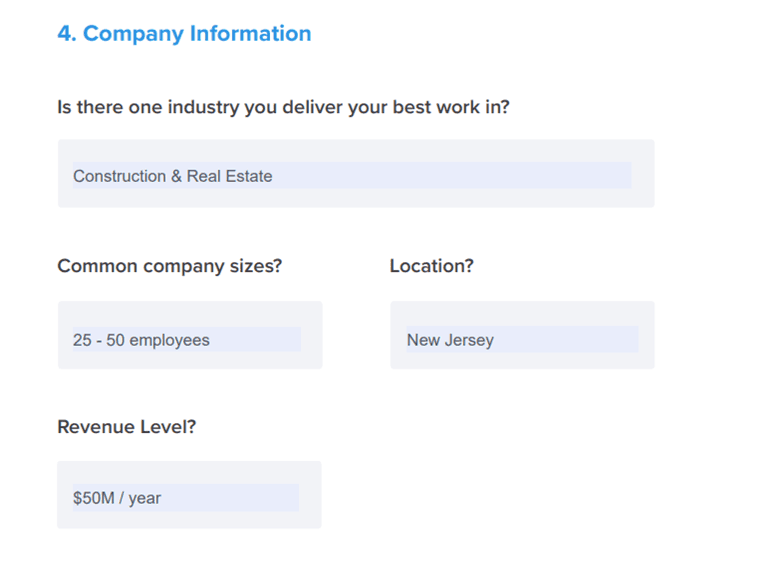
And there you have it! A well-thought-out ideal customer profile helps your agency streamline outreach efforts and get the most out of your new business ventures. Not only does it narrow down a niche to target, but it also gives you specific pain points to align with your agency’s product offering.
Strategies for Applying Your ICP
You've meticulously crafted your ICP, uncovering the pain points, goals, and characteristics of your perfect client. Now, it's time to unleash the power of those insights and truly integrate them into your agency's growth strategy.
1. Content is King (But Only with the Right Crown)
Think of your content as a bridge between your agency and your ideal client. Those pain points you identified? They're the foundation for creating content that resonates deeply with your ICP. Every blog post, webinar, or case study should address their specific challenges, anxieties, and aspirations. Don't simply churn out generic articles; offer highly valuable, niche solutions that position your agency as the go-to expert in understanding and solving their unique problems.
2. Your Sales Funnel: A Tailored Journey
Your ICP should shape every step of your sales process, transforming it from a generic pipeline into a highly personalized journey. Your initial outreach emails can highlight common problems your ICP faces, subtly hinting at your understanding of their world. During discovery calls, focus your questions on pinpointing the specific issues they're struggling with. Finally, every proposal should present solutions tailor-made for the client's needs, showcasing your agency's deep knowledge of their industry and unique challenges.
3. Networking: Not Spray and Pray
Networking is undeniably valuable, but are you maximizing the time you invest? Your ICP allows you to focus those efforts like a laser. Research where your ideal clients are active – industry conferences, LinkedIn groups, online forums, or specialized communities. Instead of generic mingling, focus on building genuine connections. Offer valuable insights and advice based on your deep understanding of their market. This establishes trust and positions your agency as a knowledgeable and invested partner, not just another business card in the stack.
Beyond the Basics
Remember, applying your ICP requires a mindset shift. Consider these additional insights:
Review Existing Materials:
Does your current website, case studies, and marketing collateral reflect and speak to your ideal client? Revise those if necessary.
Metrics Matter:
Track which ICP-aligned strategies are the most effective. Analyze your website traffic sources, qualified lead origins, and closed deals to identify which channels align best with your ICP.
The ICP is a living, breathing tool meant to evolve alongside your agency's growth. By truly integrating it into your content, sales, and networking efforts, you'll be firmly on the path to attracting and winning the best clients for your business.
Tailoring Outreach Based on Buyer Personas
Understanding your ideal client at the company level is a crucial first step. But remember, you're not selling to faceless organizations, you're connecting with individual decision-makers. This is where buyer personas come into play, adding depth and nuance to your ICP strategy.
1. Communication Is Not One-Size-Fits-All
Think about your ideal client's key decision-makers. Are they analytical types who crave data-driven insights? Relationship-focused leaders who prioritize connections and trust? Or perhaps busy executives who need information presented clearly and concisely? Understanding these communication preferences is vital for crafting outreach that resonates. Tailor your email style, presentation decks, and even your conversational approach to match their preferred communication methods.
2. Choose Your Channels Wisely
Does your ideal buyer persona religiously check their LinkedIn inbox, or are they more likely to be found scrolling through industry Twitter feeds? Some personas might still favor traditional communication like phone calls and well-crafted emails. Knowing where your target personas spend their time online and how they prefer to consume information will maximize your outreach success.
3. Personalization is Your Secret Weapon
Generic pitches are easily ignored. To truly stand out, personalize your messages to address the specific pain points, motivations, and goals outlined in your buyer personas. Reference their company's recent achievements, industry challenges, or even their LinkedIn posts to demonstrate you've done your research. This level of tailored attention shows that you're invested in understanding their specific needs and priorities.
Example in Action
Imagine your ICP includes marketing directors within fast-growing e-commerce businesses. One buyer persona might be the data-obsessed analyst who responds best to statistics and case studies proving your agency's ROI. Another persona could be a more creatively minded director seeking fresh ideas. Customize your outreach accordingly by highlighting either hard data or showcasing recent trend-setting campaigns that caught your eye.
Remember: Buyer personas enhance your ICP
By understanding the individuals within your ideal client companies, you unlock the key to hyper-personalized outreach that resonates and converts.
Bring all of your ideal client’s metrics, and much more, together with a comprehensive Client Report Template or integration specific templates like a professional Google Business Profile Report Template. Try AgencyAnalytics free for 14 days!
Putting It All Together: The Client Profile Template
Developing a robust Ideal Client Profile is the foundation of targeted marketing and sales. However, by layering in real-world examples, applying the ICP across your agency's activities, and tailoring your outreach with buyer personas in mind, you create an exceptional client acquisition strategy. This level of targeted effort is exactly what will set your agency apart. And more importantly, it'll help you build lasting partnerships with the clients you truly deserve.
I know. Creating client profiles—from collecting all the information and drawing necessary conclusions—can be challenging at first.
To make this essential task a little easier, we've created an ideal client profile template to guide you through the process.
The document lists all the information you need to collect, and then, organizes it for you into relevant insights.
Ready to attract clients that truly fit your agency’s strengths? Use our free client profile template to define your ICP and start focusing on the clients who will drive your long-term success.
FAQs About Ideal Client Profiles
Still have questions about Ideal Client Profiles? Don’t worry—we’ve got you covered
Developing an Ideal Client Profile (ICP) clarifies who your best-fit clients are—and why. With a detailed ICP, your team avoids wasted outreach and focuses on prospects that match your agency’s strengths. It sharpens messaging, improves conversion rates, and keeps marketing and sales aligned on the same high-value targets.
Start by analyzing your highest-value clients. Review firmographics, buying patterns, and customer journeys. Combine CRM data with interviews, surveys, and performance metrics to uncover shared traits. Real-world evidence forms the foundation of an ICP that reflects your most profitable client relationships.
An ICP helps agencies filter out unqualified leads early and focus only on high-potential prospects. It aligns outreach with real pain points, directs budget toward the best channels, and ensures campaigns attract clients who are both qualified and ready to buy.
Your ICP should evolve as your agency does. Revisit your ICP at least once or twice a year—or whenever your agency adds new services, shifts niches, or notices changes in top-performing clients. Regular updates ensure your targeting evolves alongside your business.
CRM systems like HubSpot, Pipedrive, or Salesforce keep firmographic and behavioral data organized. LinkedIn Sales Navigator helps identify prospects matching your ICP, while Google Analytics and AgencyAnalytics dashboards reveal performance trends among your best-fit clients.
Aim for specific, not restrictive. Include industry, company size, revenue range, and key decision-maker roles—but don’t over-define. If your ICP starts excluding clients who would still be profitable and aligned, it’s too narrow.
A target market defines everyone who could benefit from your services; an ICP focuses on the clients who will benefit the most. Think of it as moving from a wide net to a laser focus—the ICP shows where to invest time and budget for the greatest return.
Definitely. Many agencies develop multiple ICPs for different service lines or verticals—say, one for eCommerce SEO and another for local lead generation. Just keep each distinct enough to support personalized outreach and messaging.
Your ICP shapes everything from ad targeting to messaging. Align each campaign with your ICP’s priorities and pain points to boost click-through rates, reduce acquisition costs, and improve client retention—because you’re speaking directly to those most likely to succeed with your agency.

Written by
Joe is the co-founder and CEO of AgencyAnalytics, a marketing reporting platform used by more than 7,000 agencies. With experience creating multiple businesses, he thrives on tackling the challenges of sustainable growth and innovation.
Read more posts by Joe KindnessSee how 7,000+ marketing agencies help clients win
Free 14-day trial. No credit card required.


